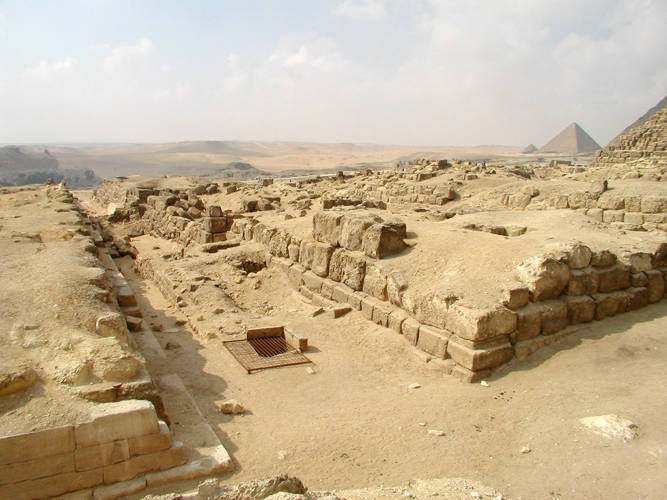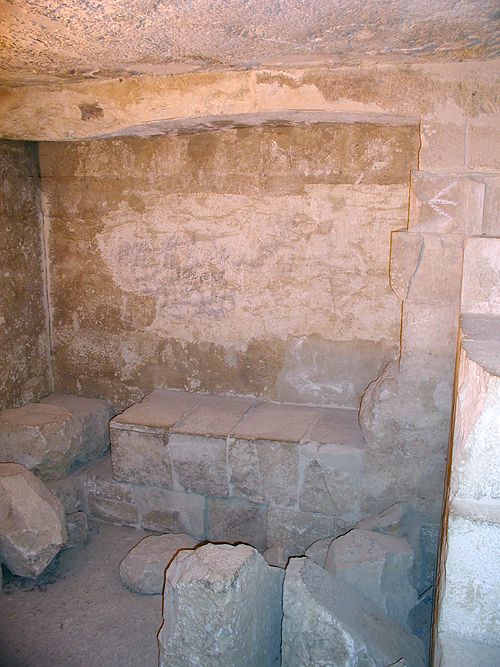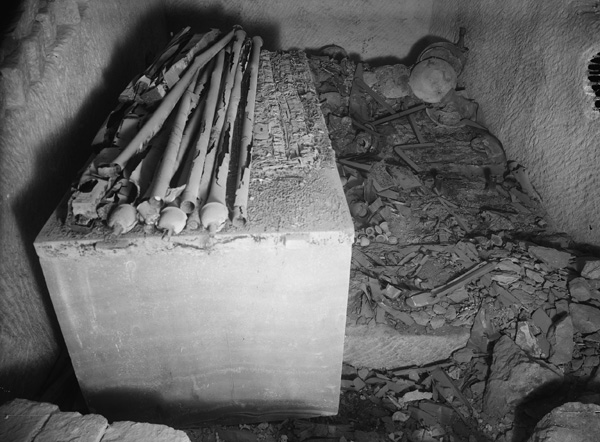|
Giza East Field
The East Field is located to the east of the Great Pyramid of Giza and contains cemetery G 7000. This cemetery was a burial place for some of the family members of Khufu. The cemetery also includes mastabas from tenants and priests of the pyramids dated to the 5th and 6th Dynasty. Porter, Bertha and Moss, Rosalind L. B., ''Topographical Bibliography of Ancient Egyptian Hieroglyphic Texts, Reliefs, and Paintings. Volume III. Memphis. Part I. Abû Rawâsh to Abûṣîr.'' 2nd edition, revised and augmented by Jaromír Málek, The Clarendon Press, Oxford 1974PDF from The Giza Archives, 29,5 MBRetrieved February 10, 2017. The East Field consists of the three Queen's pyramids and a number of mastabas labeled Cemetery G 7000. Reisner constructed a timeline for the construction of the East Field. The first two Queen's Pyramids, G 1a and G 1b, were likely started in year 15-17 of King Khufu. Usually Queen's pyramids were constructed to the south of the king's pyramid, but in this instan ... [...More Info...] [...Related Items...] OR: [Wikipedia] [Google] [Baidu] |
Minkhaf I
Minkhaf I was an ancient Egyptian prince of the 4th Dynasty. He was a son of Pharaoh Khufu, half-brother of Pharaoh Djedefre and elder brother of Pharaoh Khafre., p. 60 His mother may have been Queen Henutsen.Porter, Bertha and Moss, Rosalind, ''Topographical Bibliography of Ancient Egyptian Hieroglyphic Texts, Statues, Reliefs, and Paintings'' Volume III: Memphis, Part I Abu Rawash to Abusir. 2nd edition; revised and augmented by Dr Jaromir Malek, 1974. Retrieved from gizapyramids.org Minkhaf had a wife and at least one son, but their names are not known. Minkhaf served as vizier possibly under Khufu or Khafre. Tomb Minkhaf was buried in the double mastaba numbered G 7430-7440 in the East Field, which is part of the Giza Necropolis. The construction of the mastaba started during the reign of his father Khufu. The mastaba contained an interior chapel and an exterior chapel consisting of four rooms. One of the rooms was built to house at least four statues. The niches were l ... [...More Info...] [...Related Items...] OR: [Wikipedia] [Google] [Baidu] |
Queen Pyramid Of Hetepheres (G1a)
Queen or QUEEN may refer to: Monarchy * Queen regnant, a female monarch of a Kingdom ** List of queens regnant * Queen consort, the wife of a reigning king * Queen dowager, the widow of a king * Queen mother, a queen dowager who is the mother of a reigning monarch Arts and entertainment Fictional characters * Queen (Marvel Comics), Adrianna "Ana" Soria * Evil Queen, from ''Snow White'' * Red Queen (''Through the Looking-Glass'') * Queen of Hearts (''Alice's Adventures in Wonderland'') Gaming * Queen (chess), a chess piece * Queen (playing card), a playing card with a picture of a woman on it * Queen (carrom), a piece in carrom Music * Queen (band), a British rock band ** ''Queen'' (Queen album), 1973 * ''Queen'' (Kaya album), 2011 * ''Queen'' (Nicki Minaj album), 2018 * ''Queen'' (Ten Walls album), 2017 * "Queen", a song by Estelle from the 2018 album '' Lovers Rock'' * "Queen", a song by G Flip featuring Mxmtoon, 2020 * "Queen", a song by Jessie J from the 2018 ... [...More Info...] [...Related Items...] OR: [Wikipedia] [Google] [Baidu] |
Pyramid G1-a
G1-a is one of the subsidiary pyramids of the Giza East Field of the Giza Necropolis, located immediately to the eastern side of the Great Pyramid of Giza. It was built during the Fourth Dynasty of Egypt. The tomb is the northernmost of the three pyramids of the queens and has a base of wide and originally a height of ; the pyramid has lost two-thirds of its original height. In the west wall of the burial chamber a small niche was dug in which were found fragments of basalt. It is also known as the Pyramid of Hetepheres I as discovered by Mark Lehner; it was originally thought to belong to Queen Meritites I. References Giza Plateau Pyramids of the Fourth Dynasty of Egypt See also *Pyramid G1-b *Pyramid G1-c *Pyramid G1-d * List of Egyptian pyramids This list presents the vital statistics of the pyramids listed in chronological order, when available. See also * Egyptian pyramids * Great Sphinx of Giza * Lepsius list of pyramids * List of Egyptian pyramidia * List ... [...More Info...] [...Related Items...] OR: [Wikipedia] [Google] [Baidu] |
Miroslav Verner
Miroslav Verner (born October 31, 1941 in Brno) is a Czech egyptologist, who specializes in the history and archaeology of Ancient Egypt of the Old Kingdom and especially of the Fifth Dynasty of Egypt. Biography Verner was the director of the Czechoslovak and later Czech Institute of Egyptology at the Faculty of Arts, Charles University in Prague for twenty-five years, and led the Czech excavations at Abusir. He has also been associated with the Universities of Vienna and Hamburg as well as the Charles University in Prague and the American University in Cairo. Verner has been active in archaeological work since 1964, and he has been excavating at Abusir since 1976. In 1998, the tomb of Iufaa Iufaa was an Egyptian priest and administer of palaces who lived around 500 BC. His mummy was discovered in an unmolested tomb by Czech archaeologists under the direction of Ladislav Bareš and Miroslav Verner in February 1998. The discovery of an ..., an Egyptian priest and administer of ... [...More Info...] [...Related Items...] OR: [Wikipedia] [Google] [Baidu] |
Hetepheres I
Hetepheres I was a queen of Egypt during the Fourth Dynasty of Egypt (c. 2600 BC) who was a wife of one king, the mother of the next king, the grandmother of two more kings, and the figure who tied together two dynasties. Biography Hetepheres I may have been a wife of King Sneferu, and was the mother of King Khufu. It is possible that Hetepheres had been a minor wife of Sneferu and only rose in prominence after her son ascended the throne. She was the grandmother of two kings, Djedefre and Khafre, and of queen Hetepheres II. Her titles include: King's Mother (''Mut-nisut, mwt- nswt''), Mother of the King of the Two Lands (''Mut-nisut-biti, mwt- nswt- bjtj''), Attendant of Horus (''Khet-heru, ḫt-hrw''), and God's Daughter of his body (''Zat-netjer-net-khetef,'' '' zꜣt- nṯr- nt- ẖt .f'').Grajetzki, ''Ancient Egyptian Queens – a hieroglyphic dictionary'', London, 2011. The marriage of Hetepheres I to Snefru solidified his rise to the throne. Because she carrie ... [...More Info...] [...Related Items...] OR: [Wikipedia] [Google] [Baidu] |
Meritites I
Meritites I was an ancient Egyptian queen of the 4th Dynasty. Her name means "Beloved of her Father". Several of her titles are known from a stela found at Giza. She was buried in the middle Queen’s Pyramid in Giza (''Pyramid G 1b''). Meritites was a daughter of King Sneferu and his consort of unknown name. Meritites married her (half?-)brother, King Khufu. With Khufu, she was the mother of the Crown Prince Kawab, and possibly Djedefre. Both Queen Hetepheres II and Pharaoh Khafre have been suggested as children of Meretites I and Khufu as well, and it is possible that Meritites II was a daughter of Meritites I as well. Auguste Mariette recorded a stela at Giza in which Meritites is said to be a favorite of both Sneferu and Khufu: King’s wife, his beloved, devoted to Horus, Mertitytes. King’s wife, his beloved, Mertitytes; beloved of the Favorite of the Two Goddesses; she who says anything whatsoever and it is done for her. Great in the favor of Snefr great in the favor o ... [...More Info...] [...Related Items...] OR: [Wikipedia] [Google] [Baidu] |
George Andrew Reisner
George Andrew Reisner Jr. (November 5, 1867 – June 6, 1942) was an American archaeologist of Ancient Egypt, Nubia and Palestine. Biography Reisner was born in Indianapolis, Indiana. His parents were George Andrew Reisner I and Mary Elizabeth Mason. His father's parents were of German descent. Reisner gained B.A., M.A. and Ph.D. degrees from Harvard University, before becoming a travelling fellow. He married Mary Putnam Bronson, with whom he had a daughter, also called Mary. In 1889, Reisner was head football coach at Purdue University, coaching for one season and compiling a record of 2–1. Archaeology career Upon his studies at Jebel Barkal (The Holy Mountain), in Nubia he found the Nubian kings were not buried in the pyramids but outside of them. He also found the skull of a Nubian female (who he thought was a king) which is in the collection of the Peabody Museum of Archaeology and Ethnology at Harvard. Reisner believed that Kerma was originally the base of an Egypt ... [...More Info...] [...Related Items...] OR: [Wikipedia] [Google] [Baidu] |
Sixth Dynasty Of Egypt
The Sixth Dynasty of ancient Egypt (notated Dynasty VI), along with the Third, Fourth and Fifth Dynasty, constitutes the Old Kingdom of Dynastic Egypt. Pharaohs Known pharaohs of the Sixth Dynasty are listed in the table below. Manetho accords the dynasty 203 regnal years from Teti to Nitocris, while the Turin Canon assigns 181 regnal years, but with three additional kings concluding with Aba – discounting the reigns of the added Eighth Dynasty kings, this is reduced to 155 regnal years. This estimate varies between both scholar and source. History The Sixth Dynasty is considered by many authorities as the last dynasty of the Old Kingdom, although ''The Oxford History of Ancient Egypt'' includes Dynasties VII and VIII as part of the Old Kingdom. Manetho writes that these kings ruled from Memphis, since their pyramids were built at Saqqara, very close one to another. By the Fifth Dynasty, the religious institution had established itself as the dominan ... [...More Info...] [...Related Items...] OR: [Wikipedia] [Google] [Baidu] |
Fifth Dynasty Of Egypt
The Fifth Dynasty of ancient Egypt (notated Dynasty V) is often combined with Dynasties III, IV and VI under the group title the Old Kingdom. The Fifth Dynasty pharaohs reigned for approximately 150 years, from the early 25th century BC until the mid 24th century BC. Chronology The Fifth Dynasty of Egypt is a group of nine kings ruling Egypt for approximately 150 years in the 25th and 24th centuries BC. The relative succession of kings is not entirely secured as there are contradictions between historical sources and archaeological evidence regarding the reign of the shadowy Shepseskare. Rulers Known rulers in the Fifth Dynasty are listed below. Manetho assigns 248 years of rule to the Fifth Dynasty; however, the pharaohs of this dynasty more probably ruled for approximately 150 years. This estimate varies by both scholar and source. The Horus names and most names of the queens are taken from Dodson and Hilton. Manetho writes that the Dynasty V kings ruled from Elephan ... [...More Info...] [...Related Items...] OR: [Wikipedia] [Google] [Baidu] |
Fourth Dynasty Of Egypt
The Fourth Dynasty of ancient Egypt (notated Dynasty IV) is characterized as a "golden age" of the Old Kingdom of Egypt. Dynasty IV lasted from to 2494 BC. It was a time of peace and prosperity as well as one during which trade with other countries is documented. The Fourth Dynasty heralded the height of the pyramid-building age. The relative peace of the Third Dynasty allowed the Dynasty IV rulers the leisure to explore more artistic and cultural pursuits. King Sneferu's building experiments led to the evolution from the mastaba-styled step pyramids to the smooth sided “true” pyramids, such as those on the Giza Plateau. No other period in Egypt's history equaled Dynasty IV's architectural accomplishments.Egypt: Land and Lives of the Pharaohs Revealed, (2005), pp. 80–90, Global Book Publishing: Australia Each of the rulers of this dynasty (except for Shepseskaf, the last) commissioned at least one pyramid to serve as a tomb or cenotaph. The Fourth Dynasty was the sec ... [...More Info...] [...Related Items...] OR: [Wikipedia] [Google] [Baidu] |
Nefertkau I
Nefertkau I was a 4th Dynasty princess of ancient Egypt. She was the eldest daughter of King Sneferu and hence a half-sister to King Khufu. She was the mother of Nefermaat II and the grandmother of Sneferukhaf. Nefertkau is explicitly said to be a daughter of Sneferu in inscriptions from the tomb of her son and her grandson. Kurt Heinrich Sethe argued from the inscription in Nefermaat’s tomb that Nefertkau had married her own father and that Nefermaat was Sneferu’s son. George Andrew Reisner argued against this theory and suggested that Nefertkau may have married Khufu. He does allow for the possibility that Nefertkau married a noble man whose name was lost. Nefertkau may have buried in mastaba G 7050 at Giza. The tomb is not inscribed however so that the ownership is somewhat conjectural.Bertha Porter and Rosalind Moss Rosalind Louisa Beaufort Moss, FSA (21 September 1890 – 22 April 1990) was a British Egyptologist and bibliographer, noted for her work on ''The Topogr ... [...More Info...] [...Related Items...] OR: [Wikipedia] [Google] [Baidu] |






_-_046_(cropped).jpg)
